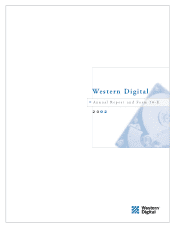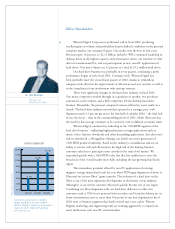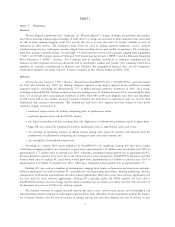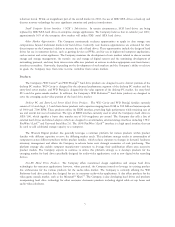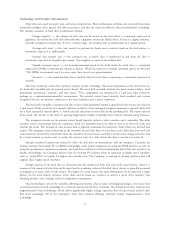Western Digital 2002 Annual Report Download - page 11
Download and view the complete annual report
Please find page 11 of the 2002 Western Digital annual report below. You can navigate through the pages in the report by either clicking on the pages listed below, or by using the keyword search tool below to find specific information within the annual report.Technology and Product Development
Hard drives are used to record, store and retrieve digital data. Their performance attributes are currently better than
removable or Öoppy disks, optical disk drives and tapes, and they are more cost eÅective than semiconductor technology.
The primary measures of hard drive performance include:
""Storage capacity'' Ì the amount of data that can be stored on the hard drive Ì commonly expressed in
gigabytes. As used in the hard disk drive industry, a gigabyte means one billion bytes. A byte is a digital character,
typically comprised of eight bits. A bit is a binary digit, the smallest unit of information in a digital system.
""Average seek time'' Ì the time needed to position the heads over a selected track on the disk surface Ì
commonly expressed in milliseconds.
""Internal data transfer rate'' Ì the sustained rate at which data is transferred to and from the disk Ì
commonly expressed in megabits per second. One megabit is equal to one million bits.
""Spindle rotational speed'' Ì the nominal rotational speed of the disks inside the hard drive Ì commonly
expressed in RPMs, revolutions per minute or latency. While the reference to spindle rotational speeds of 5400 and
7200 RPMs is commonly used, in some cases these speeds are approximations.
""Acoustics'' Ì the sound intensity that is emitted while the hard drive is operating Ì commonly expressed in
decibels.
All of the Company's hard drive products employ similar technology. The main components of the hard drive are
the head disk assembly and the printed circuit board. The head disk assembly includes the head, media (disks), head
positioning mechanism (actuator) and spin motor. These components are contained in a hard base plate protective
package in a contamination-controlled environment. The printed circuit board includes both standard and custom
integrated circuits, an interface connector to the host computer and a power connector.
The head disk assembly is comprised of one or more disks positioned around a spindle hub that rotates the disks by
a spin motor. Disks are made of a smooth substrate to which a thin coating of magnetic materials is applied. Each disk
has a head suspended directly above it, which can read data from or write data to the spinning disk. The sensor element
of the head, also known as the slider, is getting progressively smaller, requiring more accurate manufacturing processes.
The integrated circuits on the printed circuit board typically include a drive interface and a controller. The drive
interface receives instructions from the computer, while the controller directs the Öow of data to or from the disks and
controls the heads. The location of data on each disk is logically maintained in concentric tracks which are divided into
sectors. The computer sends instructions to the controller to read data from or write data to the disks based on track and
sector locations. Guided by instructions from the controller, the head stack assembly is pivoted and swung across the disk
by a head actuator or motor until it reaches the selected track of a disk, where the data is recorded or retrieved.
Industry standard interfaces are utilized to allow the disk drive to communicate with the computer. Currently, the
primary interface for desktop PC's is EIDE. Increasingly, work station computers are using the EIDE interface as well. As
computer performance continues to improve, the hard drive will need to deliver information faster than this interface can
handle. Accordingly, the Company believes that the desktop PC industry plans to transition to higher speed interfaces
such as ""serial ATA'' to handle the higher data transfer rates. The Company is working to develop products that will
support these higher speed interfaces.
Storage capacity of the hard drive is determined by the number of disks and each disk's areal density, which is a
measure of the amount of data that can be stored on the recording surface of the disk. Areal density is generally measured
in megabits per square inch of disk surface. The higher the areal density, the more information can be stored on a single
platter. As the areal density increases, fewer disks and/or heads are required to achieve a given drive capacity, thus
reducing product costs through reduced component requirements.
Head technology is one of the variables aÅecting areal density. Due to rapid technological changes, there have been
several generations of head technology in a relatively short period of time. Currently, the desktop hard drive industry uses
magnetoresistive head technology, which allows signiÑcantly higher storage capacities than the previously utilized thin-
Ñlm head technology. All of the Company's hard drive product oÅerings currently employ magnetoresistive head
technology.
6

